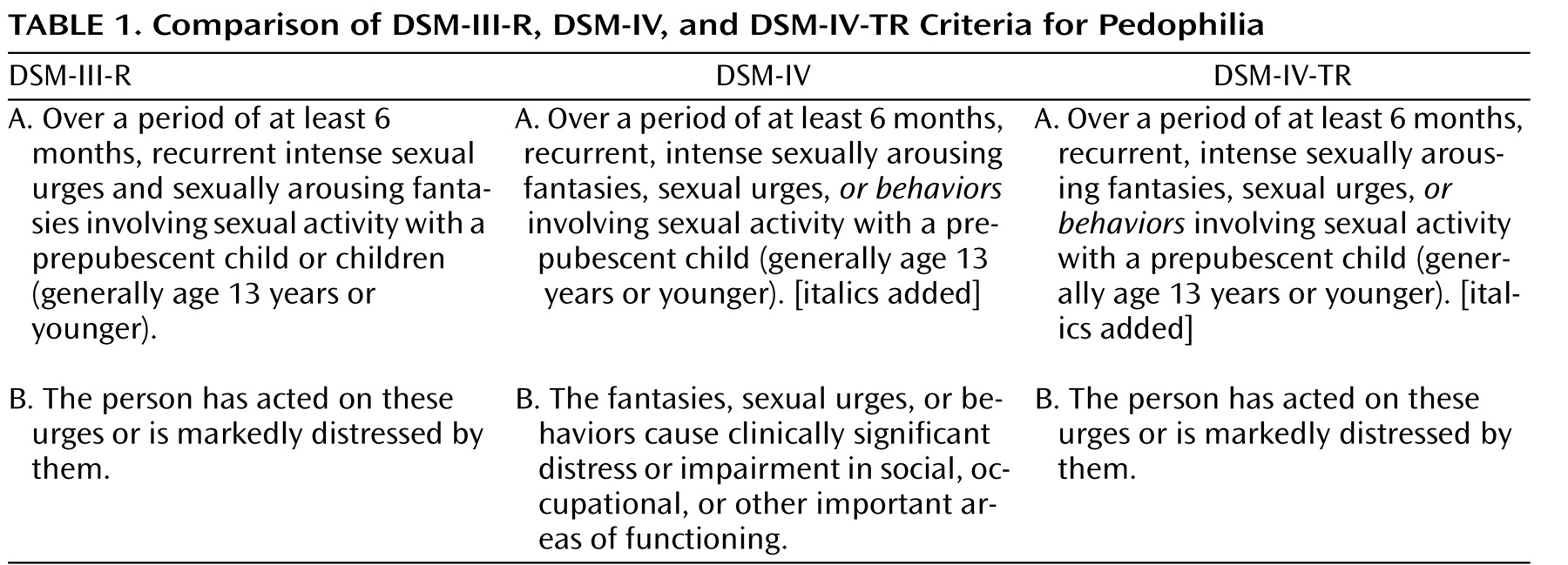Although DSM-IV-TR includes many close judgment calls, it contains only one outright mistake: in criterion A of the paraphilia section. The unintended consequences following what we thought was a small wording change provide a cautionary tale for DSM-V. The mistake arose from the decision to add the following criterion to most disorders in DSM-IV: “the disturbance causes clinically significant distress or impairment in social, occupational, or other important areas of functioning.” This was a reminder that the symptom criteria alone are insufficient to define mental disorder
(1) . In the paraphilia section, the new wording replaced DSM-III-R criterion B, which had set the significance threshold based on either acting on the urges or experiencing distress (see
Table 1 for pedophilia criteria). Furthermore, criterion A was amended (by adding “behavior” along with “fantasies” and “urges”) to emphasize that it is behavior that most typically brings individuals to clinical attention.
The reworded definition resulted in two unanticipated problems. First, conservative religious groups mistakenly worried that the change meant DSM-IV did not recognize pedophilia as a mental disorder unless it caused distress
(2 –
4) . To eliminate this misinterpretation, the original DSM-III-R criterion B was reinstated in DSM-IV-TR for those paraphilias involving nonconsenting victims (i.e., pedophilia, voyeurism, exhibitionism, frotteurism, and sexual sadism)
(5) .
The minor adjustment in criterion A caused more serious problems. The addition of “or behaviors” led some forensic evaluators to conclude that sexual offenders might qualify as having a mental disorder based only on their having committed sexual offenses (e.g., rape). In many states with sexually violent predator statutes, the diagnosis of mental disorder is necessary to trigger indefinite civil psychiatric commitment for sexually violent offenders after their prison terms are completed. The constitutionality of these statutes hinges on the requirement that the sexual offenses are caused by a “mental abnormality.” Although the mental abnormality mentioned in the statutes is defined by state legislature and is not equivalent to any DSM disorder, the courts have acknowledged the importance of DSM diagnoses in the determination of whether the statutorily defined mental health criteria are satisfied
(6) . The revised criterion A wording has sometimes been used to justify making a paraphilia diagnosis based solely on a history of repeated acts of sexual violence, which is then argued as satisfying the statutory mandate for the presence of a “mental abnormality”
(7,
8) . This certainly was never our intent in DSM-IV. Defining paraphilia based on acts alone blurs the distinction between mental disorder and ordinary criminality. Decisions regarding possible lifelong psychiatric commitment should not be made based on a misreading of a poorly worded DSM-IV criterion item.
We regret the confusion caused and have two recommendations: 1) although the contentious issue of sexually violent predator commitment cannot be resolved by a simple DSM wording change, we feel it is important to set the record straight and restore criterion A to its DSM-III-R wording (i.e., remove the phrase “or behaviors”) in DSM-V (if not sooner); 2) tinkering with criteria wording should be done only with great care and when the advantages clearly outweigh the risks, both because of the potentially unforeseen consequences of rewording criteria and because of the disruptive nature of all changes.


